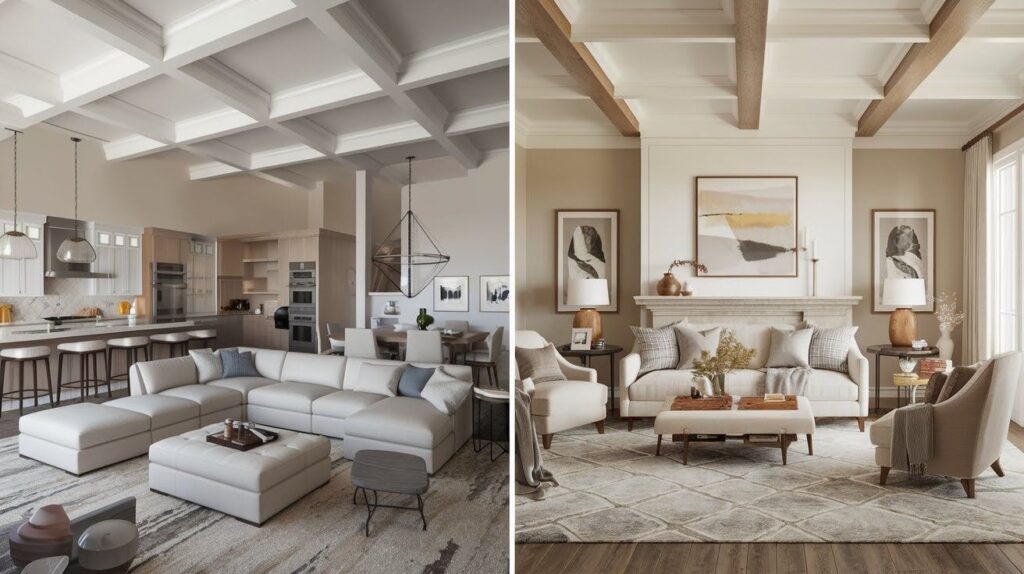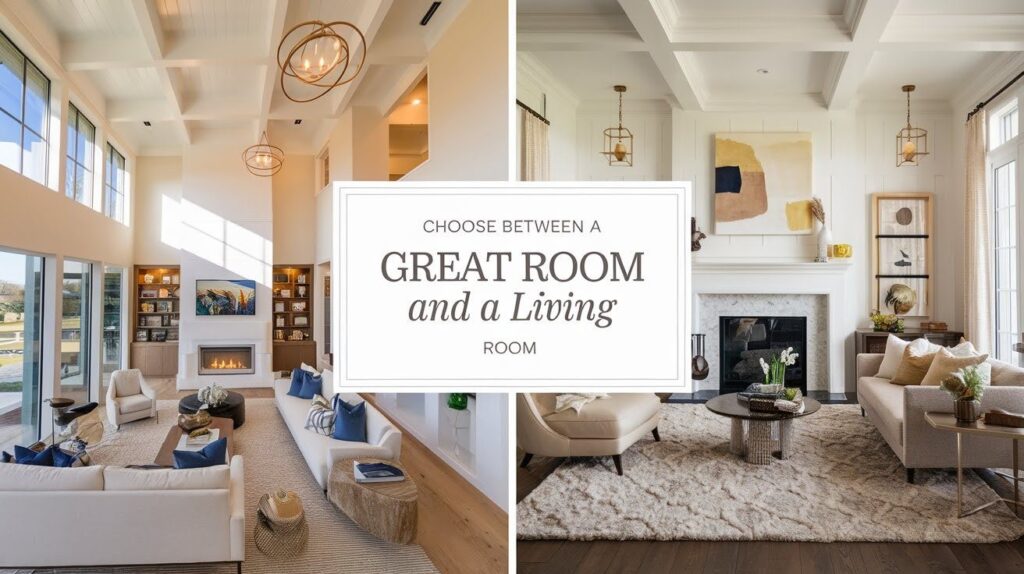Picking the right space for your home can feel overwhelming. I get it. You’re torn between a great room’s open feel and a living room’s cozy vibe. Both have their perks, but which one fits your life?
I’ve helped countless homeowners make this exact decision. In this article, I’ll break down the key differences between these two popular layouts. We’ll cover everything from family size to entertaining style to budget considerations.
You’ll learn how to evaluate your daily routines, assess your home’s structure, and match your choice to your lifestyle. By the end, you’ll know exactly which option works best for your family.
Trust me, this choice doesn’t have to be complicated. Let’s figure out what makes sense for your home.
Understanding the Basics

Let me break down these two room types so you can see the clear differences.
What is a Great Room?
Simply put, it’s where your kitchen, dining area, and living space all flow together as one big room.
A great room gives you that wide-open feel with tall ceilings and tons of natural light streaming in. You can cook dinner while chatting with family on the couch, or host a party where guests can move freely between areas. It’s all about bringing everyone together in one central hub.
What is a Living Room?
This is your classic, separate room designed specifically for relaxation and conversation.
A living room has its own four walls, creating a cozy retreat from the rest of your home. You’ll typically find it near your front door, and it serves as a dedicated space for watching TV, reading, or having intimate conversations. Think of it as your home’s quiet corner where you can escape the kitchen chaos.
Great Rooms vs Living Rooms: Key Differences
| Aspect | Great Rooms | Living Rooms |
| Size and Space | Way more square footage to work with | Compact and focused |
| Room Concept | Like having three rooms rolled into one | Creates a snug feeling where everyone gathers closer |
| Floor Space | Open floor space for kids to play, guests to mingle, and family to spread out | Intimate space for closer gatherings |
| Layout and Flow | Connects everything – no walls blocking view or interrupting flow | Clear separation from the rest of your home |
| Kitchen Connection | Can prep dinner while being part of couch conversations | Clear entry points and defined spaces separate from kitchen/dining |
| Functionality | Handles big crowds and multiple activities | Excels at intimate moments |
| Best Use Cases | Birthday parties, holiday gatherings, busy weeknight dinners | Curling up with a book, heart-to-heart conversations, movie nights |
| Lighting | Floods with natural light from big windows | Allows you to control the mood |
| Atmosphere | Bright, energetic vibe all day long | Can dim lights for movies or create warm, soft lighting for conversations |
| Privacy Level | Open and connected to other areas | More private and separate from kitchen noise |
How to Decide Which is Right for You

Let’s walk through the questions that will help you make the best choice for your home and family.
Assess Your Lifestyle
Think about how you actually live in your home every day.
Ask yourself: do you love throwing dinner parties and having friends over regularly? If yes, a great room gives you the space to entertain without feeling cramped. But if you’re more of a quiet evening person who values having a peaceful retreat after work, a living room might be your sweet spot. I always tell clients to think about their last three weekends. Were you hosting people or seeking quiet time?
Consider Family Size and Needs
Your family situation plays a huge role in this decision.
Bigger families with kids running around often thrive in great rooms. There’s space for homework at the kitchen island while mom cooks and dad watches the news. But if it’s just you and your partner, or you have one child, a living room creates that perfect cozy bubble for family time without feeling lost in a huge space.
Evaluate Your Home’s Layout
Work with what your house already gives you.
If you’re dealing with an open floor plan, fighting it with walls and divisions usually feels awkward and expensive. Great rooms flow naturally in these spaces. But if your home has that classic room-by-room layout, a proper living room often feels more organic and comfortable.
Think About Natural Light and Views
Consider how much brightness and outdoor connection you want.
Great rooms with those big windows can make your home feel connected to your yard and neighborhood. You’ll get tons of natural light throughout the day. Living rooms let you be more selective. Maybe you have a beautiful view you want to frame with smaller windows, or perhaps you prefer softer, more controlled lighting for a calmer atmosphere.
Furniture and Design Considerations

Here’s what you need to know about furnishing each space to make it work perfectly.
Furnishing a Great Room
Think big pieces and flexible arrangements that can handle multiple jobs.
I recommend starting with a large sectional that can seat your whole family plus guests. You’ll want furniture that moves easily too. Maybe an ottoman that doubles as storage, or a dining table that extends for holidays. Coffee tables with drawers, bar stools that tuck under the counter, and side tables on wheels all help maximize your space. The key is choosing pieces that serve more than one purpose since everything needs to work harder in this multi-use area.
Furnishing a Living Room
Focus on comfort and creating one clear gathering spot that draws everyone in.
Start by picking your main attraction. Is it a fireplace, your TV, or maybe a beautiful piece of art? Then arrange your furniture to face that focal point. I love using a comfortable sofa paired with two accent chairs and a soft area rug that ties everything together. Table lamps, throw pillows, and a few personal touches create that warm, inviting feeling that makes people want to stay and chat.
Quick Tips for Choosing the Right Space
For Great Rooms:
- Pick furniture that serves multiple purposes
- Use large sectionals to define different areas
- Keep pathways clear between kitchen, dining, and living zones
- Choose durable materials that handle heavy foot traffic
- Install good lighting for cooking, eating, and relaxing
For Living Rooms:
- Create one main focal point everyone can see
- Use area rugs to make the space feel cozy
- Pick comfortable seating that encourages conversation
- Add table lamps for warm, soft lighting
- Keep it simple with fewer, higher-quality pieces
General Decision Tips:
- Count how many people you entertain regularly
- Consider your family’s daily routines
- Work with your home’s existing layout
- Think about noise levels and privacy needs
- Factor in your budget for furniture and renovations
Conclusion
Choosing between a great room and living room doesn’t have to stress you out. I’ve walked you through the key differences, from size and layout to how each space fits your daily life.
Remember, there’s no wrong choice here. Great rooms work well for families who love open spaces and frequent entertaining. Living rooms suit people who want cozy, private areas for relaxation.
Take a honest look at how you actually use your home. Consider your family size, entertaining style, and existing layout. Think about whether you want that open, connected feeling or prefer defined, intimate spaces.
Trust your instincts. You know your family best. The right choice is the one that makes your daily life more comfortable and enjoyable. Your home should work for you, not against you.
Frequently Asked Questions
Can I convert my living room into a great room?
Yes, but it usually requires removing walls and major renovations. You’ll need to check if the walls are load-bearing and get proper permits before starting any construction work.
Which option costs more to furnish?
Great rooms typically cost more because you need larger furniture pieces and more of them. You’re essentially furnishing three spaces at once, while living rooms require fewer, smaller items.
Do great rooms increase home value more than living rooms?
Both can add value, but it depends on your local market and buyer preferences. Many modern buyers prefer open concepts, while others still want separate, defined spaces for different activities.
How do I keep a great room from feeling too noisy?
Use soft furnishings like rugs, curtains, and upholstered furniture to absorb sound. You can also add room dividers or bookcases to create some separation without building walls.
Which option works better for families with young children?
Great rooms often work well because parents can supervise kids while cooking or doing other tasks. However, living rooms provide a quieter space for naps and bedtime routines when needed.

